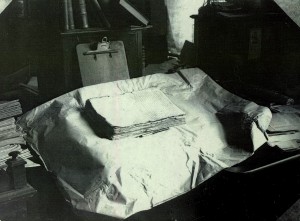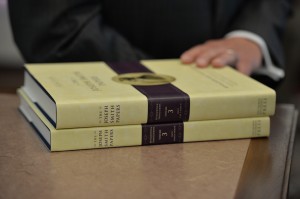Editors of “The Joseph Smith Papers” recently presented a lecture at the Gordon B. HInckley Alumni Center that shed light on the history behind the papers.

Royal Skousen of the Linguistics and English Language department at BYU described the unique history of the manuscripts of the translation of the Book of Mormon.
He covered several sources featured in this most recently released third volume of “The Joseph Smith Papers: Revelations and Translations.” These included colored photos and a facsimile transcript that can be read alongside the translation manuscript in the book. Skousen also talked about 606 documentations from the original manuscript that have never appeared in any printing of The Book of Mormon before.
Skousen spoke about the printer’s manuscript and how is it separate from the original manuscript translation. Only five-sixths of the printer’s manuscript was used to typeset the Book of Mormon first edition in 1830. The remaining was taken from the original manuscript of the translation.
Skousen explained that there were several edits that took place between the printed editions of 1830 and 1837.
“They should’ve set the whole thing from the original,” Skousen said.
Robin Jensen addressed the crowd about many of the people involved in the process of translating and printing the Book of Mormon.
Jensen said it was unique that the printer’s manuscript was kept after the original printing. He said such manuscripts are traditionally destroyed. Jensen explained that one of the three witnesses, David Whitmer, saw the manuscript as a sacred responsibility and a sacred artifact.
Jensen mentioned that Whitmer saw the printer’s manuscript as a family heirloom which he passed along to descendants. He also said Whitmer’s family did not see its sacred value and later sold it to The Reorganized Church of Jesus Christ of Latter Day Saints, now called the Community of Christ.
Jensen spoke of the “seer stone” or “chocolate-covered seer stone,” as he referred to it. Jensen also concluded that there are multiple seer stones.
“The historical record is not clear, it’s not clear at all in fact, and we wish it was more clear, but it’s pretty clear that there were multiple stones,” Jensen said. “Joseph Smith was dealing in two, maybe three, seer stones during this earlier portion.”
He explained why they featured this one in the recent release.
“The reason that we chose to feature this one is because it has the best history,” Jensen said. “The chain of custody, we can track it from Joseph Smith to Oliver Crowdery to Brigham Young to the church, so that’s why we featured that one,” Jensen explained.
He assured that the stone did, in fact, have importance and was not just a randomly chosen rock.

“This is the one that we could with relative confidence say this was associated with Joseph Smith,” Jensen said. “And it matches early descriptions.
He said the primary audience of this text is for scholars, but it is not an exclusive read.
“I think it’s a tremendous resource for members as well.”
Matthew J. Grow, director of publications in the LDS Church History Department, mentioned other text of “The Joseph Smith Papers” that will be released in the coming year, including a documented history of the Relief Society that will be published in March 2016.




